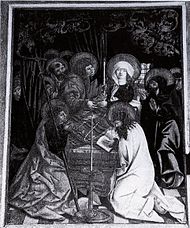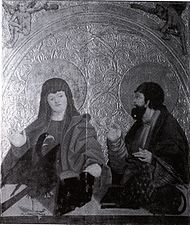High altar (Marienkirche Rieden)
The high altar of the Marienkirche in Rieden ( community Rosengarten near Schwäbisch Hall ) is considered an important work of art of the late Gothic period . It is considered the “masterpiece” of St. Mary's Church and is 9.90 m high and 2.40 m wide. The altar was built around 1510 and is attributed to Hans Beuscher . In 1937 the high altar was restored and stored during the Second World War. After the end of the war, the high altar was removed from the air raid shelter and rebuilt.
description
Closed state
Wing outer sides
The right outer wing at the top shows the flight to Egypt , while the left outer wing at the top shows Jesus' presentation in the temple . According to Andreas Deutsch, the flight to Egypt was "clearly based on a woodcut by Dürer from 1504". Since the woodcut was published in the series Das Marienleben around 1510, according to Andreas Deutsch a date of the painting before 1510 can be excluded. The painting of Jesus' Presentation in the Temple shows Mary on the right side, who is now married and wears a headscarf. Joseph stands next to her, leaning on his cane and looking at what is happening from the right edge of the picture. Simeon holds the child in his arms. A cage with sacrificial pigeons is on the table. According to Andreas Deutsch, the person depicted behind the cage should show the Rieden painter - "the beardless man behind it could have the facial features of the Rieden painter, because self-portraits of this kind in inconspicuous places were common when the altar was made".
- High altar, outer wing, above
The lower right wing shows the death of Mary while the lower left wing shows The Visitation . The painting of the Visitation shows the visit of the pregnant Maria to the old Elisabeth, who had unexpectedly become pregnant. Andreas German looks at the Heimsuchungsbild evidence for the house Buchmeister so by "the airy rippling hair and fleshy nose of Mary". According to Andreas Deutsch, the painting of Mary's death reminds of Dürer's death of the Virgin from 1510.
- High altar, outer wing, below
Predella outer wing
When the outer wings are closed you can see the outside of the predella wing: thus Mary's temple passage and the proclamation of the birth of Christ . The painting Maria's Temple Walk shows the two large figures of Maria's parents, Joachim and Anna, on the side. They bring their daughter to the temple as a little girl. She climbs the 15 steps to the temple. A monkey sits under the stairs as a symbol of evil, but it is tied up and therefore powerless. Andreas Deutsch sees evidence of Matthias Grünewald in the announcement of the birth of Christ , for example through the "facial expression of the angel Gabriel and his heavily feathered wings".
- High altar, outside of the predella wing
Passive leaf
When the outer wings are closed, the inactive wings of the altar can also be seen. On the right are St. Barbara with goblet and crown and St. Catherine with the martyr's crown and sword as an indication of her decapitation. Saints Vitus and George can be seen on the left . Vitus is shown in bourgeois costume and holds the oil kettle in his hand. Saint George appears in knight armor with a dragon at his feet. The clothing of the saint suggests that it was made around 1510.
- High altar, inactive wing
Open state
Altar shrine
When the wings are open, the altar shrine with the figures of Mary is flanked by Peter and Paul in the middle. Eduard Krüger sees a relationship to the Tüngental altar with Upper Rhine influences, which comes from Hans Beyscher : "The overall composition [of the Tüngental altar] agrees so completely with the Rieden main altar from 1510 that one has to move it closer to Beyscher" Andreas Deutsch refused, he assigns the figures to the Franconian altar tradition.
Wing insides
The insides of the wings show four carved half-reliefs depicting scenes from the life of Mary. The Annunciation is shown at the top left, and the birth of Christ below. It follows the adoration of Christ by the three kings shown at the bottom right . The coronation of Mary is shown above. According to Andreas Deutsch, the relief of the Annunciation is reminiscent of a copper engraving by Martin Schongauer (around 1450–1491). The relief of the birth of Christ is also reminiscent of a copper engraving by Schongauer, with the "Riedener carver taking over almost all of the compositional elements from Schongauer's Mesterwerk". The relief of the adoration of Christ by the three kings shows, among other things, the child who leans forward to the eldest of the three wise men. The bald man kneels in front of the child and carries a gold vessel with the letters "DNAE", which could probably be the artist's initials - "A reference to the artist ...? One does not know".
- Wing insides
Predella shrine
When open, the four church fathers Hieronymus , Ambrosius , Gregorius and Augustine can be seen in the shrine of the predella . The predella figures are probably under "Mainz influence".
Predella inner wing
The inside of the predella wing shows the two evangelists Luke and Matthew on the left and the two evangelists John and Mark on the right. The “compositional joke”, for example in the case of the four evangelists at the predella, the “impressive muted choice of colors and the expressive brushwork”, according to Andreas Deutsch, suggest an important artist. Eugen Gradmann assigns the paintings to a workshop in Schwäbisch Hall in the Nuremberg tradition - "... probably Hallish, but in Nuremberg style". Reclam's art guide also describes these as “paintings in the manner of Michael Wohlgemut ”.
- High altar, inside of the predella wing
Burst
The above the altar builds conversation Enge on; directly on top of the shrine there is a Pietà in the middle , flanked by the figures of Saints Catherine and Barbara.
back
On the back there are two coats of arms, on the left the one-headed imperial eagle, on the right the city arms of Schwäbisch Hall.
Individual evidence
- ↑ Andreas Deutsch: Great art in a small church. To the altars of the Riedener Marienkirche. P. 103.
- ↑ Andreas Deutsch: Great art in a small church. To the altars of the Riedener Marienkirche. P. 120.
- ↑ a b c d Andreas Deutsch: Great art in a small church. To the altars of the Riedener Marienkirche. P. 124.
- ↑ Andreas Deutsch: Great art in a small church. To the altars of the Riedener Marienkirche. P. 114.
- ↑ Andreas Deutsch: Great art in a small church. To the altars of the Riedener Marienkirche. Pp. 113-114.
- ↑ Andreas Deutsch: Great art in a small church. To the altars of the Riedener Marienkirche. P. 116.
- ↑ Andreas Deutsch: Great art in a small church. To the altars of the Riedener Marienkirche. P. 113.
- ↑ Andreas Deutsch: Great art in a small church. To the altars of the Riedener Marienkirche. P. 122.
- ^ Eduard Krüger: Tüngental - an outpost of Halle art. In: Hohenloher Heimat. No. 40, December 24, 1949, p. 158 f.
- ↑ Andreas Deutsch: Great art in a small church. To the altars of the Riedener Marienkirche. P. 107.
- ↑ Andreas Deutsch: Great art in a small church. To the altars of the Riedener Marienkirche. Pp. 107-108.
- ↑ Andreas Deutsch: Great art in a small church. To the altars of the Riedener Marienkirche. P. 108.
- ↑ Andreas Deutsch: Great art in a small church. To the altars of the Riedener Marienkirche. P. 122.
- ↑ a b Andreas Deutsch: Great art in a small church. To the altars of the Riedener Marienkirche. P. 123.
- ↑ Eugen Gradmann : In wood, large shrine of the high altar ... In: The art and antiquity monuments of the city and the Oberamt Schwäbisch-Hall . Paul Neff Verlag, Esslingen a. N. 1907, OCLC 31518382 , pp. 105 ( archive.org ).
- ↑ Herbert Brunner, Alexander von Reitzenstein: Reclams Art Guide Germany 2. Stuttgart 1979, p. 553.
- ↑ a b Andreas Deutsch: Great art in a small church. To the altars of the Riedener Marienkirche. P. 120.
literature
- Eugen Gradmann : Vineyards . In: The art and antiquity monuments of the city and the Oberamt Schwäbisch-Hall . Paul Neff Verlag, Esslingen a. N. 1907, OCLC 31518382 , pp. 103-108 ( archive.org ).
- Andreas Deutsch: Great art in a small church. To the altars of the Riedener Marienkirche. In: Uta Friederich-Keitel, Rainer Keitel (ed.): Rieden im Rosengarten 1290–1990. Rieden 1990, pp. 103-136.
- Dagmar Zimdars: Handbook of German Art Monuments . Baden-Württemberg 1: The administrative districts of Stuttgart and Karlsruhe. Deutscher Kunstverlag, Munich 1993, ISBN 3-422-03024-7 , p. 641.
- Andrea Neuwirth: The late Gothic high altar of the Marienkirche in Rieden in the rose garden. Master's thesis, Bamberg 1994.
Web links
- Photos of the high altar in the Baden-Württemberg State Archives
















